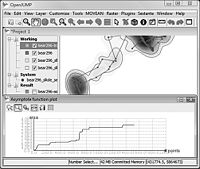Difference between revisions of "Movement Analysis"
m |
(→Contact) |
||
| Line 40: | Line 40: | ||
== Contact == | == Contact == | ||
You can contact me, Stefan Steiniger, writing an email to sstein(=at=)geo.uzh.ch. Alternatively you may contact [http://www.ucalgary.ca/~ahunter/ Andrew Hunter]. | You can contact me, Stefan Steiniger, writing an email to sstein(=at=)geo.uzh.ch. Alternatively you may contact [http://www.ucalgary.ca/~ahunter/ Andrew Hunter]. | ||
| + | |||
| + | == Future Development & Bug Reporting == | ||
| + | There are a couple of ideas for future developments (e.g. to evaluate co-occurrence for two individuals). However, we don't have public research funding currently for this. If you wish a specific feature it should be possible to implement that if you can fund it. However, bug fixing is free of cost and depends on (my) free time. If you find a bug then let me (Stefan) know. As the source code is freely available others can do feature development and bug fixing too. Please let us know if you want to contribute, need help, or even write how you use HoRAE. | ||
Revision as of 13:29, 15 November 2011
We have create a toolbox for the free GIS software OpenJUMP that allows to analyse movement data, called OpenJUMP HoRAE - Home Range Analysis and Estimation (pronounced: hooray). The software is and can be freely distributed under the General Public License verison 2.0 (GPL) - so you can give it to your co-worker or even modify it.
Contents
About the Home Range Analysis Toolbox
The toolbox contains functions for visualization of movement tracks and allows the creation and analysis of animal home ranges. Home range estimation methods that have been implemented are (see also the article below):
- Minimum Convex Polygon (MCP),
- Kernel Density Estimation (KDE), methods: (a) href, (b) LSCV, and (c) ad-hoc (region split)
- Line-based KDE, scaled and un-scaled
- Brownian Bridges
- Line Buffer
- Local Convex Hulls (LoCoH), methods: radius r, k-1 nearest neighbors, alpha region.
Additionally one can:
- perform an Asymptote analysis for MCP, Point-KDE, Line-Buffer
- Calculate core areas
- Classify home range parts
- Derive the Skeleton for a home range region.
- Analyze the daily travel
The toolbox was originally developed to analyse location data from grizzly bears (ursus arctos) collected with GPS collars within the Grizzly Bear Programm of the Foothills Research Institute (FRI, Alberta, Canada). Funding was provided by Canadian Phase IV GEOIDE grant (#3).
Download
The software should run on Windows and Linux systems. Currently there is a bug that does not allow saving data on MacOSX systems. However, if you write me (Stefan: sstein) I can send you a patched version that allows saving to files, but can't save to a database. Anyway - here to the downloads:
- download software (package including OpenJUMP 1.4 with the HoRAE toolbox)
- install instructions - note, the software requires Java Runtime Environment (JRE) installed
- a short article (pdf) that describes the functions of the toolbox (article under submission)
Some preliminary results for a comparison of the estimators with grizzly bear data: GIScience 2010 extended abstract (pdf) and poster (pdf).
A test dataset with 14 GPS points to check out the functions of the toolbox is shipped with the distribution and can be found in the folder "/testdata/".
Documentation
We work on a wiki page with some more online documentation. However, the ABODE manual may be a good start, since most functions implemented were "inspired" by the ABODE toolbox (but software calculations are differently). For now you may check our Home Range Calculation Manual, which contains some info on how using our toolbox.
other supporting documents:
- Steiniger, S. (2009, unpublished): A vector-based algorithm to detect core, edge, patch and corridor areas and comparison with its raster-based complement. (pdf) --- The document explains the different types of classes such as core, edge, patch and corridor that can be derived with the function
MOVEAN>HRE Analysis>Extract Core, Patch, Edge; and:MOVEAN>HRE Analysis>Extract Corridors. - Steiniger, S., Hunter, A.J.S. (2010, unpublished): A scaled line-based kernel density estimator for the retrieval of utilization distributions and home ranges from GPS movement tracks. (pdf) --- The document explains how the line-based Kernel Density Estimators (KDE) works and compares it with Point-based KDE and the Brownian Bridge (BB) estimator. The function is to be found under
MOVEAN>HRE>Line KD>....
Contact
You can contact me, Stefan Steiniger, writing an email to sstein(=at=)geo.uzh.ch. Alternatively you may contact Andrew Hunter.
Future Development & Bug Reporting
There are a couple of ideas for future developments (e.g. to evaluate co-occurrence for two individuals). However, we don't have public research funding currently for this. If you wish a specific feature it should be possible to implement that if you can fund it. However, bug fixing is free of cost and depends on (my) free time. If you find a bug then let me (Stefan) know. As the source code is freely available others can do feature development and bug fixing too. Please let us know if you want to contribute, need help, or even write how you use HoRAE.
